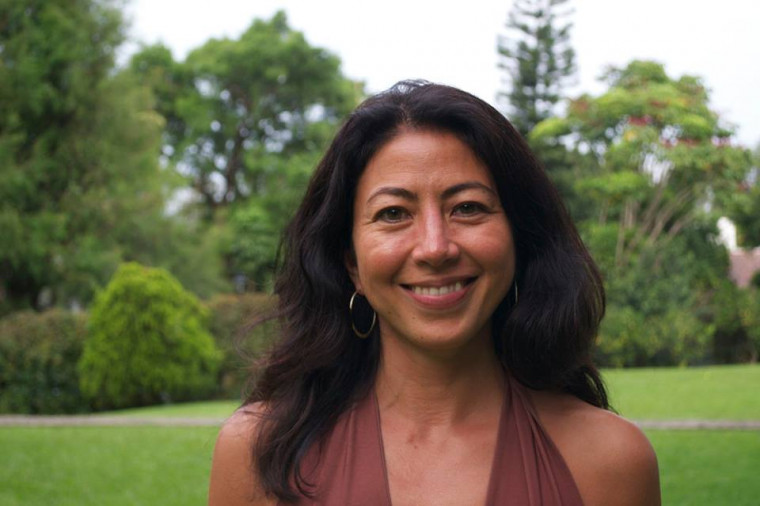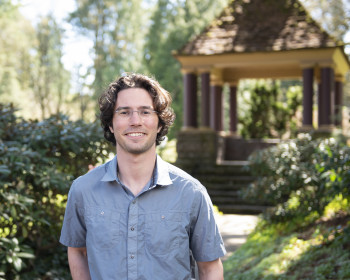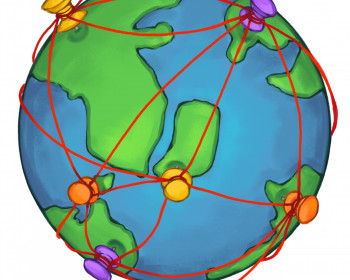Upcoming book releases from history faculty
Open gallery

by Daniela Jiménez BA ’14
Two Lewis & Clark history professors, Reiko Hillyer and Elliott Young, have books due out this coming fall.
Reiko Hillyer, Designing Dixie: Tourism, Memory, and Urban Space in the New South
Professor of American History Reiko Hillyer is known for her ability to place the built environment at the center of conversations on history. Her class, Constructing the American Landscape, inspires gestalt shifts among her students, who may never again be able to look at another gas station or government building without seeing the underlying social forces that created them. It does not come as a complete surprise then that her new book, Designing Dixie: Tourism, Memory, and Urban Space in the New South, will combine her interests in landscape history, cultural history, and political economy. In it, Hillyer draws out the relationships between cultural and political power, and their connections to physical space.
The creation of the New South, Hillyer argues, was anything but natural. Rather, Southern cities in the Post-Civil War era were deliberately fashioned to downplay their “moonlight and magnolias” plantation nostalgia, opting instead for a new image that would be an entreaty to Northern capitalist investment as well as Northern tourism. Situating her study on the tourist economies of three cities—St. Augustine, Florida, Richmond, Virginia, and Atlanta, Georgia—Hillyer explained that she was drawn to the ways in which tourism served as a vehicle for sectional reconciliation between North and South.
“What I’m trying to do,” Hillyer said, “is link the history of public memory in the South with the history of political economy. Usually those are looked at in two very separate ways. I’m looking at trying to bridge those two, and seeing how memory could serve the interest of the political economy of the New South.”
The idea for the book was originally meant to be a dissertation on tourism to Florida.
“I thought that would be really fascinating, as a kind of frontier state that remakes itself from a jungle to the American Mediterranean,” Hillyer said. However, during her preliminary research, she found herself more drawn to the imagery and rhetorical motifs in guidebooks about Florida, and became more interested in examining what it meant politically for a southern state like Florida—a confederate state, and the third to secede— to call itself mediterranean rather than southern. Hillyer wisely counsels her students to be willing to reorient themselves in their writing projects if they find themselves uninspired by their source material.
“You might need to do a different kind of history,” says Hillyer. “We need to find the type of work that speaks to our skills and sensibilities.”
Designing Dixie will be forthcoming from University of Virginia Press.
Elliott Young, Alien Nation: Chinese Migration in the Americas from the Coolie Era through World War II
Associate Professor of History and department chair Elliott Young celebrates the impending release of his new book, Alien Nation: Chinese Migration in the Americas from the Coolie Era to World War II. Spanning a century and the majority of the globe, Young’s book was a 14-year endeavor. Unlike most other historians of Chinese migrants in the Americas, Young hopes to overcome the myopia of narratives that are told from the perspective of the nation-state. Instead, he tells a transnational story, one that as he explains “focuses on the people who really fall outside of the boundaries of national history,” and thereby reveals the ways in which the modern constructions of “the alien” have come to define own understandings of our rights of citizenship.
“The importance of the story,” Young said, “has a lot to do with the present day continued migration of people, not only from Mexico and Central America across the U.S.-Mexico border and Canadian border, but really from all around the world. There was a story on National Public Radio about the U.S.-Mexico border talking about Ethiopians and people from Eastern Europe on the border crossing illegally, so I think the idea that these networks of clandestine migration continue to this day shows the importance of understanding the origins of that system.”
His story draws upon sources from all over the world—the British parliamentary papers, Spanish archives in Madrid, the U.S. National Archives in Washington, as well as archives from Cuba, Canada, and Mexico—and consciously spans the century between the 1840s to the 1940s to fill in the historiographical gap often left by historians focusing either on the life of the Chinese contract laborers in the early development of the coolie trade or on the history of the Chinese Exclusion Act from 1882 and beyond. His heroes? The undocumented migrants themselves—those who may end up in courts or detention centers, but who evade the state immigration authorities and transit clandestinely throughout the Americas via underground migrant networks, those who manage to bamboozle immigration authorities and leave bureaucracies and legislation efforts scrambling for control in their wake.
Young is intrigued by the ways in which the original concept of free migration in the 16th-century had almost completely disappeared by the end of the 19th-century, and how nations came to assert their rights to limit migration across their national boundaries.
“That system that seems so natural to us now is actually a very recent phenomenon,” Young said. Indeed, the United States’ Chinese Exclusion Act of 1882 was the first major legislation to restrict migration, and was duly followed by countries like Canada, Cuba, and Mexico, first excluding Chinese and later other groups and nationalities. Young’s book takes on the ambitious challenge of tracing the emergence of today’s system of controlled and monitored migration, and explores the way in which the idea of the alien as the non-citizen subject, in Young’s own words, “gives power to the rights of citizenship, by the very nature of contrasting what aliens don’t have and the violence that they are subject to.”
This book does not have one chapter on the Chinese in Mexico, another in Peru, another in Hong Kong and so on, but is instead truly about this “alien nation.” Rather, the source materials reveal nation states in conversation with one another, collectively attempting to puzzle out the right way to address the migrations of Chinese workers.
In this way, Young attempts to shift the conversation away from descriptions of unassimilated migrants as “pathological” or “deviants,” which sociologists have adopted throughout the 20th-century. Rather, Young views the Chinese as having power and creating community within their diasporic networks. Ultimately, he attempts to portray them “from their own perspective, how they’re actually tied into transnational communities of merchants, smuggling networks, Chinese secret societies. They’re not alienated from that world,” he states. “We just don’t see that because they’re not visible by the state authorities—they’re missing that.”
Professor Young offers this parting piece of wisdom—“Go out, find a border, and cross it.”
Look for this book fall from the University of North Carolina Press. Learn more here
A version of this article originally appeared in Footnotes, the history department newsletter.
History Department
More Newsroom Stories
Public Relations is located in McAfee on the Undergraduate Campus.
MSC: 19
email public@lclark.edu
voice 503-768-7970
Public Relations
Lewis & Clark
615 S. Palatine Hill Road MSC 19
Portland OR 97219

